Williams Flexion Exercise (WFE)
What is a Williams flexion exercise (WFE)?
Williams’s flexion exercises are a series of therapeutic exercises designed to alleviate lower back pain and improve flexibility in the lumbar spine. These physical exercises are designed to strengthen the gluteal and abdominal muscles and improve lumbar flexion in an effort to treat low back pain without surgery.
Additionally, it extends the iliofemoral ligament as well as the erector spinae, hamstring, and tensor fasciae latae muscles. The technique was initially created by Dr. Paul C. Williams, a Dallas orthopaedic specialist at the time.
For patients looking for a non-surgical solution to cure their low back pain, Williams’ back flexion exercises are available. For those who do not wish to have low back surgery, these exercises are a successful alternative.
Williams’s back flexion exercises have been recommended over time to patients with a variety of low back pain-related illnesses, even in the absence of a valid diagnosis. Physical therapists and doctors have created numerous variations of this exercise, which is typically given by physiotherapists and orthopaedics.
As opposed to the McKenzie method of exercise, which increases lumbar extension through motion. Both William’s Back flexion exercises and the McKenzie method of extension exercises were developed in the 1930s. The Mechanical Diagnosis and Therapy method (MDT) is another name for the McKenzie exercise. Only a few studies have been done to assess the effectiveness of the Williams flexion exercise and the McKenzie extension exercise side by side.
History of Williams flexion exercises (WFE)
The Regen exercise, often known as the “squat exercise,” which involves squatting and emphasizing the convexity of the lumbar region, was promoted in the 1930s by Tennessee orthopaedic surgeon Eugene M. Regen. The Regen exercise gave rise to the WFEs. In response to his clinical observation that the majority of patients with low back pain had degenerative vertebrae owing to degenerative disc degeneration, Williams first published his own modified exercise programme for patients in 1937.
These exercises were initially created for men and women under the age of 50 who had increased lumbar lordosis, x-ray films that revealed a reduction in the disc space between the lumbar spine segments (L1-S1), and chronic, low-grade complaints.
Rationale
Williams felt that stress placed on the intervertebral disc as a result of bad posture is the fundamental cause of all pain. He postulated that the posterior components of the intervertebral disc were put under stress by the lordotic lumbar spine, which led to the disc’s early malfunction. He was worried about the accumulation of extension pressures that were damaging to the disc due to the absence of flexion in daily activities.
Goals of Williams flexion exercises (WFE)
These exercises are designed to strengthen the abdominal and gluteal muscles, open the intravertebral foramina, stretch the back extensors, hip flexors, and facets, and mobilise the lumbosacral junctions. Additionally, it provides lower trunk stability and pain relief.
Mechanism of Williams flexion exercises (WFE)
The exercises listed will achieve a correct balance between the flexor and extensor groups of postural muscles, according to Williams. Williams stated that the best outcomes required a posterior pelvic-tilt position.
Exercises that involve both flexion and extension have been proven to relieve back pain and achieve the following:
All foraminal dimensions should be increased greatly, including the canal area, midsagittal diameter, and subarticular sagittal diameter.
Procedure of WFE ( Williams flexion exercises)
These exercises were carried out while lying flat on the ground or another flat surface. The main move is to grab the legs and pull the knees to the chest, holding them there for a few seconds. There were modifications. The patient then unwinds, lowers his or her legs, and performs the exercise once more. The stretching of ligamentous tissues, opening of the intervertebral foramen, and distraction of the apophyseal joints are thought to be the main advantages.
Following the variations of Williams’s flexion exercises (WFEs) are below:
Pelvic tilt
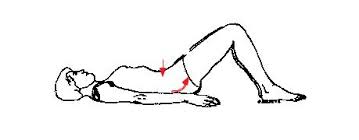
Lie on your back on a yoga mat or a comfortable surface with your knees bent and feet flat on the floor, hip-width apart.
Take a deep breath in, and as you exhale, gently tilt your pelvis backwards, flattening your lower back against the floor.
For 5 to 10 seconds, hold. Exercises for pelvic tilting build up the low back muscles.
Single Knee to chest:
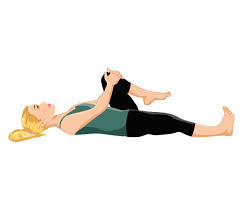
Lie on your back on a yoga mat or a comfortable surface with your legs extended straight and your arms by your sides, palms facing down.
Pull your right knee slowly towards your shoulder and hold the position for five to ten seconds.
Repeat the same movement with the opposite leg, bringing the other knee to your chest.
Continue to alternate legs, performing the stretch 2-3 times on each side.
Double knee to chest:

As with the prior exercise, start by. Pull the left knee to the chest after bringing the right knee to the chest, and keep both knees there for five to ten seconds.
Drop each leg one at a time. Knee-to-chest stretches might help your low back become more flexible.
Partial sit-up
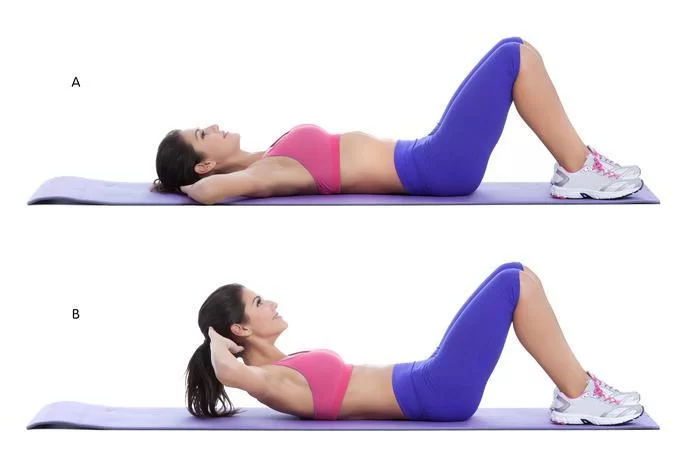
Perform exercise 1’s pelvic tilt, then slowly raise your head and shoulders off the floor while maintaining this position. Briefly maintain.
Return to the starting position carefully.
Partial sit-ups strengthen the abdominal muscles.
Hamstring stretch

Begin in a long seated position with knees completely stretched and toes pointed towards the ceiling.
Maintaining extended knees, outstretched arms over the legs, and forward-gazing eyes, slowly descend the trunk forward over the legs.
The muscles on the back of your thighs become more flexible with the hamstring stretch.
Hip Flexor Stretch

With the left (front) knee bent and the right (back) knee held firmly straight, put one foot in front of the other. When the left knee reaches the axillary fold (the area under the armpit), flex forward through the trunk. Repeat with the left leg in the back and the right leg out. At the front of your hips are the hip flexor muscles. Particularly if you spend a lot of the day sitting down, these muscles are frequently stiff. It increases hip mobility.
Squat
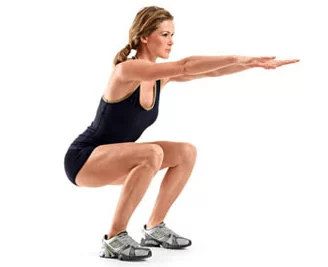
Stand with your feet shoulder-width apart and parallel. The individual gently lowers his body by flexing his knees while attempting to keep his trunk as parallel to the floor as possible, his eyes fixed forward, and his feet flat on the ground.
Your hip muscles will get stronger from the squat workout. If you struggle with balance, do this exercise close to a firm surface.
Lumbar flexion position with rotation
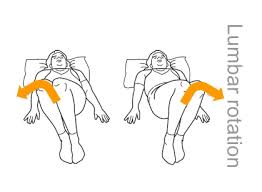
Do Supine Position yourself on the floor with your feet flat and your knees bent. For stability, extend your arms to the sides.
Drop your knees softly to one side, trying to touch the floor while keeping your shoulders slightly raised. Bring your knees back to the starting position after holding for a brief period of time.
On the opposite side, repeat. The muscles and joints in the lower back and hips can be stretched and moved around with the aid of this workout.
Seated Forward Bend
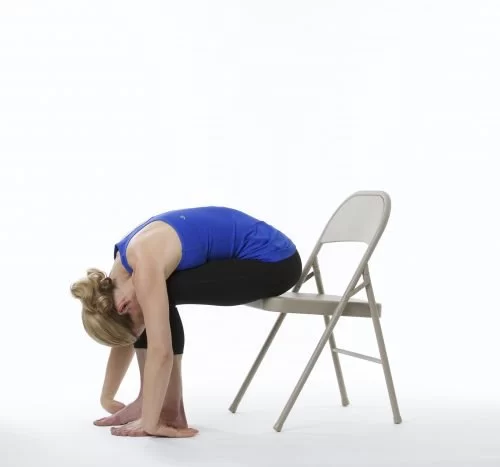
Sit on the edge of a sturdy chair with your feet flat on the floor and hip-width apart. Slowly bend forward from your hips, reaching towards your feet or the floor with your hands.
Keep your back straight as you fold forward, leading with your chest and maintaining a neutral neck position. Feel the stretch in your lower back and hamstrings. Hold for about 20-30 seconds and then slowly return to an upright position.
Benefits of Williams’s flexion exercises
Williams’s flexion exercises offer several potential benefits, particularly for individuals experiencing lower back pain or seeking to improve lumbar spine flexibility. Some of the main advantages include:
- Lower back pain relief: One of the primary goals of Williams’s flexion exercises is to reduce lower back pain. The emphasis on lumbar flexion helps to decompress the intervertebral discs, reducing pressure on nerves and alleviating pain caused by conditions such as disc herniation or degenerative disc disease.
- Increased flexibility: Regularly performing these exercises can help improve the flexibility of the lumbar spine. Increased flexibility can lead to a better range of motion and reduced stiffness in the lower back, making it easier to perform daily activities and exercise.
- Muscle stretching: Williams’s flexion exercises target various muscles in the lower back, including the erector spinae, hamstrings, and hip flexors. Stretching these muscles can help relieve tension and tightness, which are common contributors to lower back pain.
- Improved blood flow: The repetitive movement involved in flexion exercises encourages increased blood flow to the lower back region. Improved circulation can facilitate the delivery of oxygen and nutrients to the affected area, supporting the healing process.
- Enhanced core strength: While Williams’s flexion exercises mainly focus on lumbar flexion, they also engage the core muscles. Strengthening the core can provide better support and stability for the lower back, reducing the risk of future injuries.
- Easy to perform: These exercises generally do not require any special equipment, making them easily accessible for most individuals. They can be done at home or in a supervised rehabilitation setting.
- Low impact: Williams’s flexion exercises are typically low impact, which means they put minimal stress on the joints. This makes them suitable for people with certain physical limitations or those recovering from injuries.
- Complementary to other treatments: These exercises can be used alongside other treatments for lower back pain, such as physical therapy, chiropractic care, or medication. Integrating Williams’s flexion exercises into a comprehensive treatment plan can enhance overall results.
- Empowerment and self-management: Learning and practicing these exercises empower individuals to take an active role in managing their lower back pain. They can become a valuable tool for self-care and pain management.
As with any exercise program, it’s crucial to perform Williams’s flexion exercises correctly and consult with a healthcare professional or therapist before starting, especially if you have pre-existing back conditions or medical concerns. Additionally, individual responses to these exercises may vary, and what works well for one person may not be as effective for another. Personalization and proper guidance are key to experiencing the full benefits of these exercises while minimizing the risk of potential adverse effects.
Williams’s flexion exercises Indication
Williams’s flexion exercises are indicated for individuals experiencing lower back pain or stiffness caused by various conditions, such as:
- Degenerative disc disease: Williams’s flexion exercises can aid in increasing blood flow to the affected discs, potentially promoting healing and reducing pain associated with degenerative changes in the discs.
- Lumbar spinal stenosis: People with lumbar spinal stenosis, a condition where the spinal canal narrows and puts pressure on the spinal cord or nerves, may benefit from these exercises as they emphasize forward bending, which can open up the spinal canal and alleviate symptoms.
- Sciatica: The exercises may help reduce pressure on the sciatic nerve and provide relief for individuals experiencing sciatic pain.
- General lower back pain: For individuals with nonspecific lower back pain or discomfort, Williams’s flexion exercises can offer a gentle and effective way to stretch and strengthen the lower back muscles.
- Rehabilitation after back injuries: These exercises are often used as part of a rehabilitation program to help individuals recover from lower back injuries or surgeries.
- Improving lumbar flexibility: Williams’s flexion exercises are also indicated for individuals seeking to improve their lumbar spine flexibility and maintain a healthy back.
It’s important to note that while Williams’s flexion exercises can be beneficial for many individuals, they may not be suitable for everyone. Individuals with certain medical conditions, spinal instabilities, or other health concerns may need to avoid or modify these exercises.
Before starting any exercise program, especially if you have a pre-existing medical condition, it’s essential to consult with a healthcare professional or a qualified physical therapist. They can assess your individual health status, provide personalized recommendations, and ensure that Williams’s flexion exercises are safe and appropriate for your specific needs and limitations.
Contraindications
Williams’s flexion exercises, like any therapeutic exercises, have certain contraindications where they should be avoided or modified to ensure the safety and well-being of individuals. Contraindications for Williams’s flexion exercises include:
- Acute back injury: Individuals with recent acute back injuries, such as severe sprains, strains, or fractures, should avoid these exercises until they have healed and received clearance from a healthcare professional.
- Spinal fractures: People with spinal fractures should avoid flexion exercises, including Williams’s flexion exercises, as they may exacerbate the injury and hinder the healing process.
- Spinal instability: Individuals with known spinal instability or certain spinal conditions, such as spondylolisthesis or spondylolysis, should avoid excessive forward bending and flexion exercises.
- Spinal infections or tumors: If someone has a spinal infection or a tumor affecting the spine, these exercises may not be appropriate and could worsen the condition.
- Osteoporosis: For individuals with osteoporosis or low bone density, flexion exercises may increase the risk of vertebral fractures. It’s essential to use caution and consider alternative exercises that do not involve forward bending.
- Pregnancy: Pregnant women should avoid exercises that involve lying on their backs for an extended period, like some variations of Williams’s flexion exercises.
- Recent abdominal surgery: Individuals who have undergone abdominal surgery should avoid flexion exercises until they have fully recovered and received clearance from their healthcare provider.
- Severe pain: Anyone experiencing severe pain, particularly in the lower back or spine, should avoid these exercises until the source of the pain is properly diagnosed and treated.
- Nerve impingement: Individuals with nerve impingement or radicular symptoms should avoid excessive forward bending, as it may aggravate the condition.
- Limited hip or spine mobility: People with a limited range of motion in their hips or spine should perform these exercises with caution and avoid pushing into positions that cause discomfort.
As with any exercise program, it’s essential to consider individual health status and any medical conditions before starting Williams’s flexion exercises or any new exercise regimen. Consulting with a healthcare professional or a qualified physical therapist can help determine if these exercises are suitable or if modifications are needed to ensure safety and effectiveness. Personalized recommendations and guidance are key to incorporating exercises that are appropriate for each individual’s needs and limitations.
Summary
Williams Flexion Exercises (WFE) are therapeutic exercises designed to relieve lower back pain and improve flexibility in the lumbar spine. They emphasize forward bending to reduce pressure on intervertebral discs and stretch tight muscles. WFE are indicated for various back conditions but have contraindications for certain medical issues.
Practitioners should follow safety precautions, consult with a healthcare professional, and modify exercises as needed. The benefits include pain relief, increased flexibility, core strengthening, and improved functional fitness. WFE can be personalized to suit individual needs, making them accessible and effective for managing lower back issues.

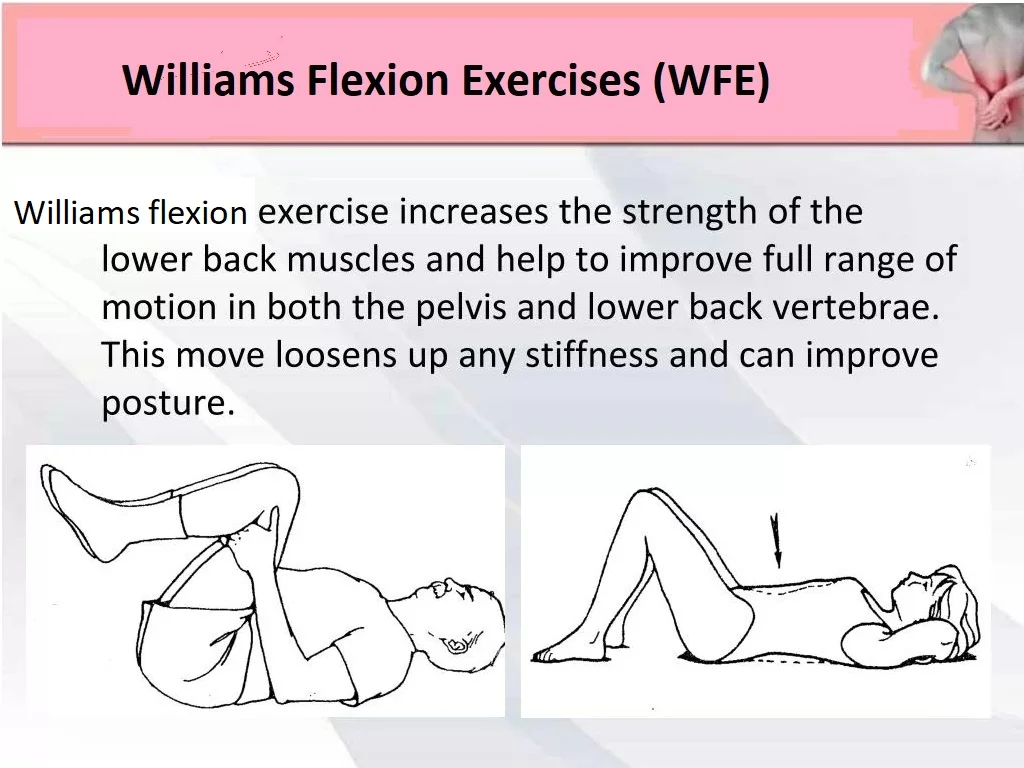

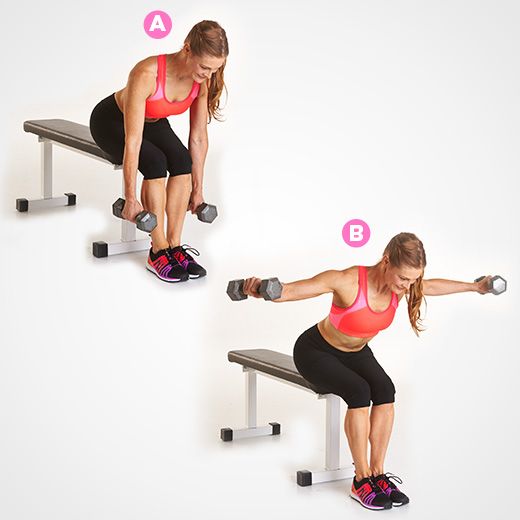


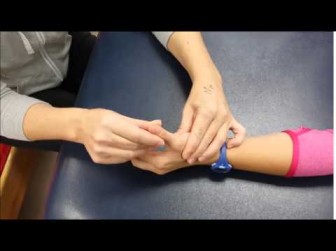
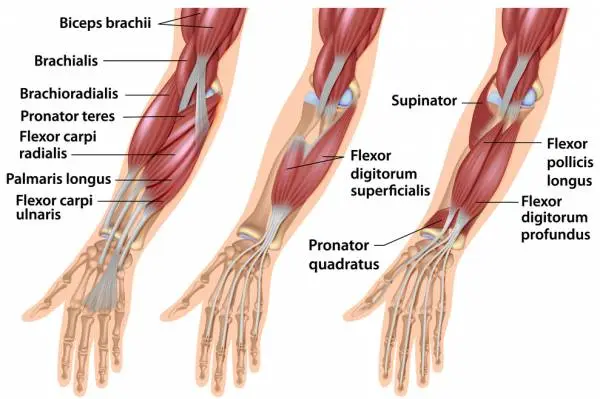
One Comment